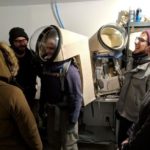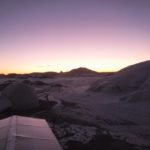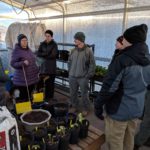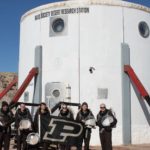Mars Desert Research Station
Mission Plan
Crew 202 – MartianMakers
Dec 28th, 2018 – Jan 12th, 2019
Crew Members:
Commander and Crew Astronomer: Dr. Cesare Guariniello
Executive Officer: Denys Bulikhov
Crew Engineer: Kasey Hilton
Health and Safety Officer and GreenHab Officer: Jake Qiu
Crew Geologist: Ellen Czaplinski
Crew Journalist: Alexandra Dukes
Mission Plan:
MartianMakers is the second all-Purdue crew at MDRS. Enthusiast and grateful for the first experience of Purdue students and alumni at the station, and eager to bring our tiny contribution to the advancement of research for human exploration of Mars, we organized a crew with one veteran of MDRS and five bright young rookies.
Crew 202 will perform various research tasks related to human exploration of Mars: some of them will be performed in the laboratory, while others require Extra Vehicular Activities (EVA), thus adding realistic difficulties to the task. This way, crew members will not only be collecting data for their research projects, but also identifying potential issues and difficulties with performing tasks while encumbered by space suits in a harsh environment. A third important aspect of the mission will be the experience of living together in a small habitat, with all the consequent psychological and social aspects that will allow the crew to challenge themselves in a realistic astronaut situation.
The main objectives of the MartianMakers analog Martian mission are:
• Keeping the highest level of fidelity and realism in the simulation. Earth analogs cannot reproduce Martian gravity and atmosphere, but the crew will keep every other aspect into consideration. This includes safety and research protocols, definition of roles and daily schedule (with ample space for personal time), EVA protocols and difficulties, communication protocols, fruitful collaboration with the program director and mission support, and adaptation to limited resources and environmental difficulties.
• Perform research in the fields of earth sciences, biology, psychology, and crew operations on Mars
• Complete outreach projects. Public relations and outreach began before the mission and will continue after it and includes outreach to the general public about analog missions and their importance, outreach to students about the crew research, and media release through Purdue university and other channels.
• Lay the foundation of continued collaboration of Purdue crews with the MDRS program.
• Following the mission, supporting MDRS with useful products and manuals for future crews.
Crew Projects:
1.
Title: Fuzzy Logic Decision Making in support of autonomy for crew EVAs
Author(s): Cesare Guariniello
Objectives: Comparison of decisions made by crew during EVAs with decisions based on a fuzzy-logic intelligent machine
Description: Prior to the mission, a simple decision-making machine based on fuzzy logic considerations has been built. When events (loss of communication, unexpected environmental difficulties, crew member injury) occur, the algorithm decides whether to continue the EVA, modify the primary objective, proceed to secondary objective, or abort the excursion based on safety of the crew, current status of the mission, achieved partial goals, and potential further acquisition of data. During the mission, events will be suggested to the crew (not simulated, for reasons of safety. It will be up to the astronauts to keep their decisions realistic), and the discussion and decision recorded and compared to that suggested by the machine
Rationale: Due to the distance between Earth and Mars, increased autonomy of the crews is fundamental. Support from Earth will be limited and time-delayed, therefore astronauts on Mars will need to be able to perform decisions autonomously. Intelligent and adaptive algorithms can provide a key support to astronauts, especially in situation of distress
EVAs: 3-4 medium to long EVAs
2.
Title: Stress levels and decision making during Extravehicular Activity (EVA)
Author(s): Denys Bulikhov
Objectives: Assess how stress experienced during simulated Extravehicular Activity (EVA) affects decision making of an astronaut
Description: Extravehicular activity is an extremely demanding task, physically and psychologically. EVA exposes astronauts to significant physiological stress. Multiple studies have shown that human decision making is strongly influenced by stress. It has been demonstrated that stress changes participant’s attitude towards risk which in case of EVA may lead to dangerous consequences. This particular study is designed to investigate the possible influence of physiological stress experienced by participants during simulated planetary EVA on their decision-making. Different conditions of stress will be simulated (no EVA, regular EVA, some level of stress after EVA). The amount of stress will be evaluated through a procedure approved by Purdue’s Institutional Review Board, involving collection of saliva and appropriate measurements.
Rationale: Astronauts perform tasks in hazardous environment, and they need to be able to make safe decisions. It is important to know how stress levels can impact the capability of decision making, so as to decide either what stress factors to mitigate or how to support the decision-making process at high-stress time
EVAs: 3 EVAs (test done after EVA, not during)
3.
Title: Study of microbial ecosystem in microgreens
Author(s): Jake Qiu
Objectives: Assess how pathogens introduced by astronauts can be released in an isolated environment and contaminate nutrients
Description: When traveling to space, everything gets sterilized except for one thing – astronauts. Humans are continuous contamination sources and many people house dormant pathogens that could potentially be released to the isolated enclosures that are required in space and on Mars. This project will identify how the microbial ecosystem in microgreens – an important nutrient source for essential vitamins that are easily degradable, can be impacted when inoculated with human-associated cell types. Locations in the habitat will be swabbed for these microbes and previously sterilized microgreens (not for consumption!) inoculated with them. The community structure of the microgreens will be analyzed throughout growth and harvest, and a NASA DNA sequencer will be used to identify any phenotypic changes and any potential pathogenic strains that could cause concern and further investigation
Rationale: Long duration missions will heavily rely on food produced in-situ. While objects and plants can be sterilized, astronauts cannot, and are therefore prone to introduce potentially dangerous pathogens in the isolated habitations. Further knowledge about the amount of pathogen spreading and the ways it can happen will support research to preserve the health status of crews
EVAs: None
4.
Title: Analysis of mineralogy and regime of sand dunes and fluvial processes
Author(s): Ellen Czaplinski
Objectives: Determine the differences between spectra taken in the field during EVAs and in the laboratory, and identify effective spectroscopic techniques for in-situ sample analysis
Description: Features found in the MDRS study area, such as paleo channels and dunes, provide opportunities to access exposures that detail their depositional environment and the role that water played in their formation. Further, studying inverted channels and dunes near MDRS contributes to our understanding of the sedimentation processes that shaped these features, providing an Earth analogue to ones found on Mars. These characteristics are suitable to support the important task of determining efficient spectroscopic techniques for in-situ sample analysis to prepare for future crewed missions to Mars. Spectral information of samples around the MDRS are useful in comparing this area to Mars. Smectites like montmorillonite and nontronite are common around the habitat and are two of the most common clay minerals found on Mars. Studying clay minerals is relevant in that the identification of specific clay minerals can offer information such as the geochemistry of the primary rocks. Analyzing these types of clays in the IR is important, since IR spectroscopy techniques have the ability to differentiate 1:1 versus 2:1 silicate-layer type clays, as well as different chemical compositions of clays (montmorillonite versus nontronite)
Rationale: This comparative study has the goal of identifying differences between spectra collected in the field and spectra measured in laboratory. Do environmental factors significantly change the spectra of samples when compared to measurements taken in the lab? Based on this analysis, appropriate techniques can be suggested for in-situ sample analysis
EVAs: 5-6
5.
Title: Composting and recycling waste on Mars
Author(s): Kasey Hilton
Objectives: Analyze some of the waste produced at MDRS as example of typical waste produce in a habitat on Mars, to determine the opportunities for recycling and composting
Description: Waste produced at the habitat will be analyzed and sorted into nitrogen rich waste (kitchen scraps, grass clippings, ect.), carbon rich waste (paper, wood chips, egg shells, ect.), and non-compostable waste, allows for the possibility of creating a compost pile. A compost pile would not only provide a way for waste to be reused that would otherwise take up space but would also provide plants with nutrients needed to grow and would introduce microorganisms into the environment. For a healthy compost, a 1:2 ratio of nitrogen rich to carbon rich waste is needed. Human waste can be used to modify the ratio towards carbon richer compost. Pending permission, a compost pile will actually be initiated inside the GreenHab, where the plants will provide the necessary oxygen for the microorganisms to start breaking down the material in the compost (which can be used as fertilizer in the GreenHab)
Rationale: Due to the restricted amount of storage available during space travel and limited resources in a Martian habitat, reducing and reusing as much waste as possible is vital. A closed-loop environmental control and life support system is a must for long-distance space travel, and once at destination, it is imperative to reuse as many resources as possible
EVAs: None
6.
Title: Classroom Outreach via asynchronous Q&A
Author(s): Alexandra Dukes
Objectives: Spread news about MDRS and analog missions in a capturing way
Description: The crew received questions from a California school (GK-3) and a Nevada classroom (1st grade) about MDRS and living on Mars. The crew will be videotaped answering the questions in a “73 questions” Vogue format
Rationale: While is it important to spread our research among experts and professionals, it is equally important to have the younger generations informed and interested in what we do!
EVAs: None
7.
Title: Messier objects for outreach
Author(s): Cesare Guariniello
Objectives: Do astronomy outreach by showing the majesty of some of the most spectacular deep sky objects
Description: Project already started before rotation at MDRS. Goal is to observe (and later filter and color) all visible objects out of the 110 in the extended Messier catalogue
Rationale: Get people interested not only in the utility but also in the beauty of space
EVAs: None
8.
Title: Radiological mapping of MDRS and surrounding areas
Author(s): Denys Bulikhov
Objectives: Create a map of radiation around MDRS
Description: Use instruments to measure the amount of certain type of radiations at different heights in the areas surrounding the habitat. Some of the measurement will be taken by instrument mounted on a lightweight drone
Rationale: While Earth is protected from radiation by the thick atmosphere, Mars is much more susceptible to high-energy radiation from space. If astronauts have to spend extended periods of time outside the protection of caves and lava tubes, it is important to know areas with lower concentration of radiations. While the levels measured at MDRS will be relatively low, this project will show techniques to map radiation on Mars
EVAs: 2-3
9.
Title: Students outreach on projects towards Martian mission
Author(s): Alexandra Dukes
Objectives: Inform students about MDRS projects with adequate level of detail
Description: The research projects of crew 202 will be explained and published on social media in three different level of difficulty, aimed at three different audiences: K-6, 7-12, College
Rationale: To engage students across education levels and get them excited about the work being done to place humans on Mars, it is fundamental to be able to speak their language. Therefore, it is important to describe each project in different ways, adequate to the audience
EVAs: None
10.
Title: Photometry of faint objects
Author(s): Cesare Guariniello
Objectives: Measure the magnitude of faint objects with MDRS-14 telescope
Description: MDRS-14 is expected to capture objects with magnitude 14-15. The project aims at pushing this boundary by a large factor, starting from relatively bright objects, like Ceres (M=8.88), to move to faint objects like Pluto (M=14.35), Makemake (M=17.15) and Haumea (M=17.40)
Rationale: Clear dark skies at MDRS give chance to show the potential of astronomy from the surface of a planet in extremely good conditions
EVAs: None
11.
Title: MARSter Chef (Martian Cooking Videos)
Author(s): Alexandra Dukes
Objectives: Provide future crews with video recipes for cooking with the food available in the habitat, and raise the interest of the general public
Description: Crew members will be filmed while preparing meals and explaining recipes that make use of food in the habitat
Rationale: Food is one of the aspects of crewed missions that are often not considered enough. To keep the crew morale high, varied and interesting recipes are often essential
EVAs: None







You must be logged in to post a comment.